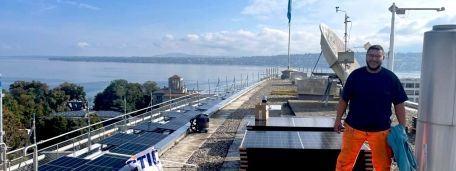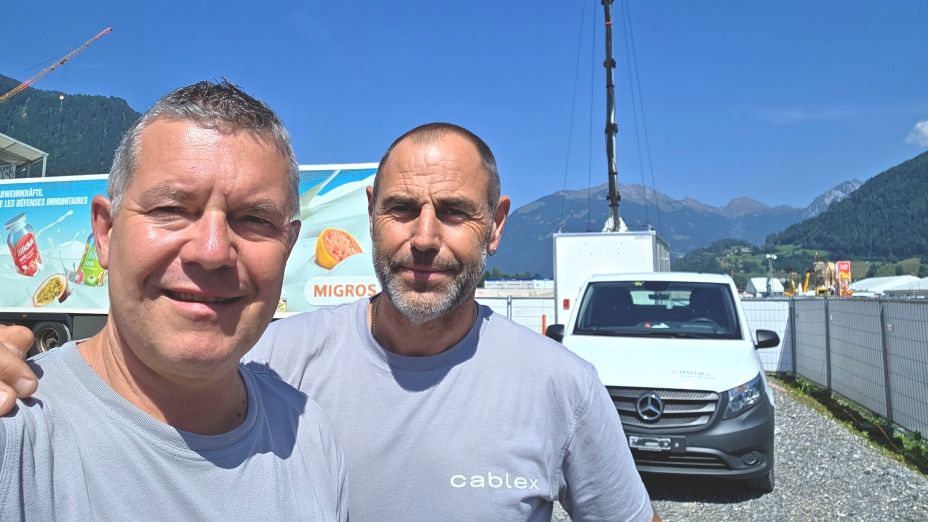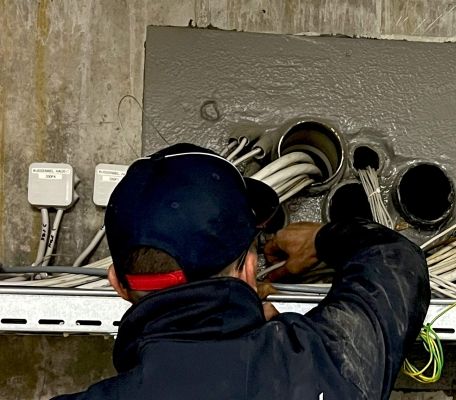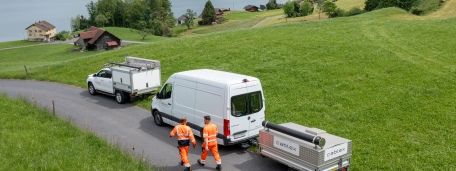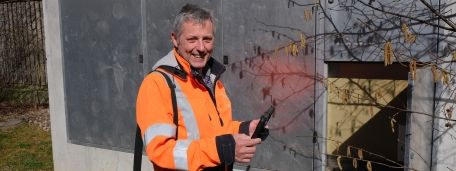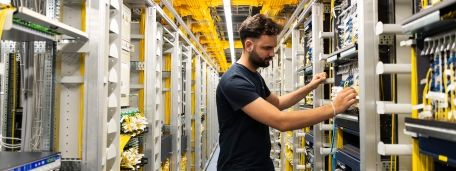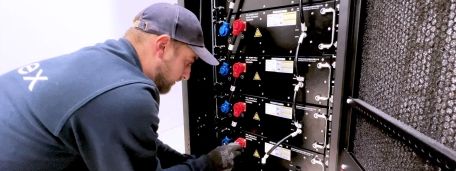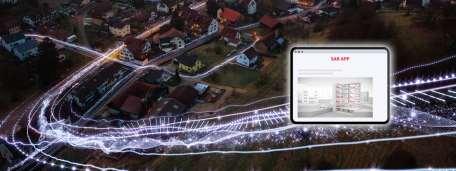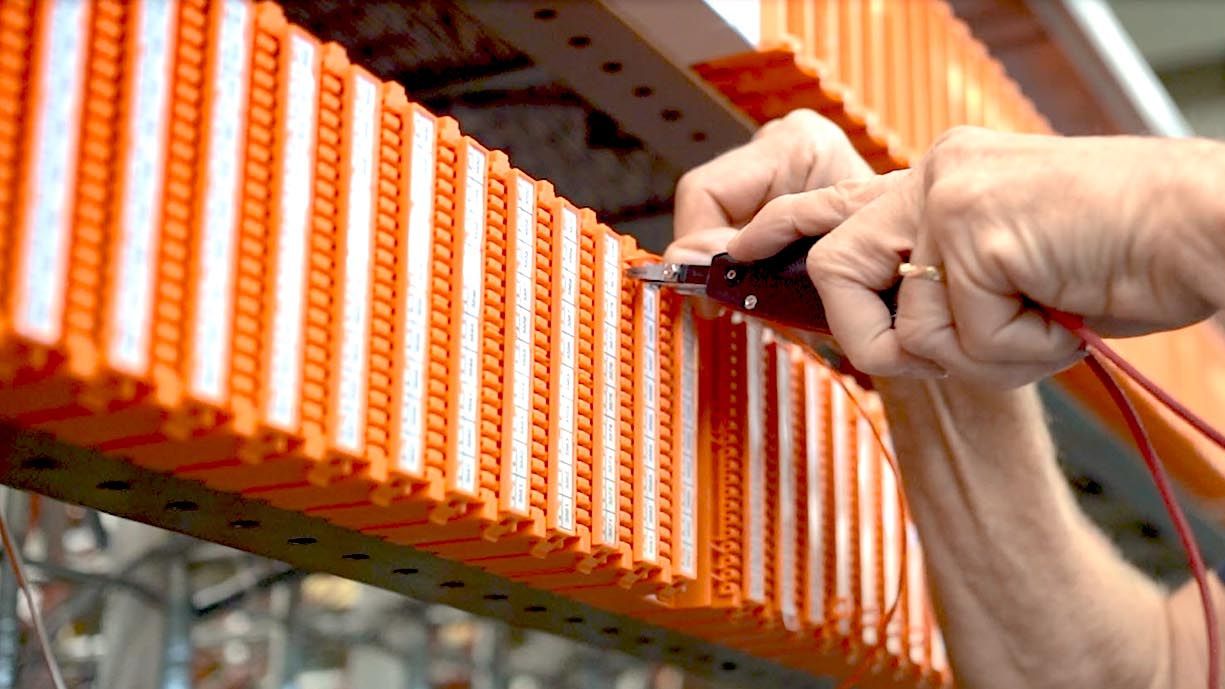
Acceptance
Inspection or testing of the installed elements (physical acceptance) and their entry in the systems (logical acceptance). The objective is for certain quality criteria to be satisfied so that the respective acceptance can be passed.
Activation
Activation of the connection in a local exchange and/or connection of the OTO by means of a fusion splice. After activation, the respective subscriptions can be obtained from any provider.
Aerial Cable
An aerial cable is an electrically-insulated cable mounted on an overhead pole.
Aggregator (AGG)
Equipment in the local exchange. From here, the data (signals) from different technologies are aggregated and consolidated so that the customer has the best possible speed at their location.
BEP-Report
The BEP report contains the information for correct splicing of the building cabling or alternatively the in-house cable to the drop cable of the network operator.
Bobbin
Large cable reel/drum.
Building Entry Point (BEP)
Logical transfer point of the optical fibre cable between Swisscom (drop) and the building owner (access, in-house). Synonym often also used: HJB = house junction box → HJB optical.
“For dimensioning of the BEP, the total number of residential units (RU) must be taken into account. The following are counted as one residential unit:
each flat (private)
each business
each building (building reserve)
If the BEP is equipped with a splitter, then this must be taken into account in the BEP dimensioning."
Whether splitters are in the BEP or in the shaft is determined by the number of RUs. For P2MP, the splitter is in the BEP as of 12 residential units.
In-house cabling and OTO-ID
The responsibility of the network operator ends with the placement of the fibres in the corresponding splice box and the OTO ID label to be applied to them. As of this point, the building owner is responsible for the activation (→ single project business case).
Cable Pipe / Cable Conduit
Plastic pipes that are laid underground. They serve to protect the optical fibre and copper cables and simplify pulling cable.
Cable Probe
Cable-pulling system in which a cable is pulled in mechanically at difficult to access locations.
Carrier Cable
In the carrier cable or suspension cable, a single cable (usually a steel cable) is installed in the cable sheath as strain relief. The cable has a cross-section reminiscent of a figure eight. Here, the conductor bundle forms the lower circle, and – usually connected via a small bar – the suspension cable forms the second, usually smaller circle. Both are encased in a common weather- and sun-resistant outer cable sheath.
Central Office (CO)
Local exchange or connection centre in which the subscriber connections converge at the corresponding main distributors with the respective technology (differentiation between glass and copper).
Commissioning
The respective infrastructure elements are put into operation for the first time. This happens physically (on-site) as well as logically (in the systems where the physical elements are managed). After successful commissioning, customers can obtain the service from any provider.
Connection
Clearly identifiable line over which the respective services, such as TV, Internet, or telephone, can be obtained.
Connectivity
Connectivity or connections. For customers, these are offered services such as Business VPN (site networking), Swisscom Ethernet Services 2.0 or Business Internet.
Copper Cable
A copper cable consists of multiple wires that are combined into single- or multi-wire bundles. They are usually sheathed and reinforced with a suitable insulating material.
Distribution Cable
The distribution cable is located in the area from the distribution point (from a sleeve) to the buildings (BEP). The term distribution cable is used in the copper and optical fibre area (see also drop).
Distributore
Device between the local exchange and the customer to distribute the trunk cables to the associated cables.
Drop (Drop Cable)
Cable area between the DP (e.g. shaft with sleeve) or feeder and the building entry point or BEP. The drop cable is also referred to as the distribution cable. The term drop is mainly used in the optical fibre area.
End of Life (EOL)
Discontinued model. These are products, components or software that are no longer produced or supported by the manufacturer and are therefore no longer available. In Swisscom Business, EOL is also used for the "End Of Line" measurement.
This power level measurement is performed after "OTO Ready" and is the final measurement of the active line at the OTO socket.
Fault
A fault is an unexpected event. A fault can be caused, for example, by a service failure, an error, external influence (e.g. construction machinery), the user or other causes.
Faul Rectification
Restoration of the performance or service.
Feeder (Feeder Cable)
Cable area between the CO and DP (e.g. shaft with sleeve). The feeder cable is also referred to as the trunk cable. The term feeder is mainly used in the optical fibre area.
Fibre
Means optical fibre here. The optical fibre is an optical waveguide. It transfers information through light impulses.
Fibre Spot or Large Residential Building Project (GWP)
Block of flats and larger residential estates as of 20 RUs that will be connected with optical fibre technology.
Fibre to the Building (FTTB)
The fibre is installed up to the building and ends there on an mCAN (usually in the basement or a technical room of the building). The signal is routed over the last few metres (from the mCAN to the flat) via a copper cable.
Fibre to the Home (FTTH)
The optical fibre is installed up to the flat and ends there on an OTO socket.
The expansion is either via P2P or P2MP.
Fibre to the Mobile Site (FTTM)
The fibre is installed up to the building with a radio mast (mobile site) and ends there on an OP. For this type of connection, there is also the term FTTA "Fiber To The Antenna".
Fibre to the Office (FTTO)
The optical fibre is installed into the building and ends there on an OP. This is an optical fibre network for business customers.
Fibre to the street (FTTS)
The optical fibre is installed into the street (up to a shaft) and ends there on an mCAN. The signal is routed over the last few metres (from the mCAN to the flat) via a copper cable.
Final FTTS Commissioning
Final commissioning takes place in several steps. During the first step, just before switching, the current status of the connected routers is checked using an app. During the second step (after the four-hour interruption), the signal is still transmitted exclusively via the existing copper cable, but the mCAN is now connected in-between (looped in). Specifically, this means that the signal is routed via the copper line to the mCAN and from the mCAN via the existing copper cable to the router. During these tests, the mCAN is supplied with power from the local exchange via the existing copper cable and no longer via a generator. An app is used to see if all of the customers are back online.
First Time Right (FTR)
Fault-free production the first time. This means that every activity on-site and in the respective systems is carried out right the first time and every time.
Home Gateway
Device that establishes the connection between the home network and the Internet with the various services (e.g. Swisscom Internet router).h1
House Junction Box/Building Entry Point (HAK/BEP)
Transfer point of the connection line to the house installation. Managed by Swisscom. The term Building Entry Poin (BEP) is used for optical fibre.
HUB
Each mobile network is divided geographically into many, adjoining, honeycomb-like regions called radio cells. That is why people refer to the cellular structure of the networks. The division into radio cells of limited size makes it possible to make optimal use of the limited number of available radio channels.
The radio cells are supplied by mobile radio base stations. These form the nodes of the networks. When planning the mobile radio networks, the aim is to find out how optimum coverage can be achieved and where that base stations are to be erected.
Identifikationscode Code of the OTO (OTO-ID)
Defined in accordance with the technical directive of the Swiss Federal Office of Communication, OFCOM (BAKOM). Contains the FTTH operator number and is a uniquely identifiable number for each residential unit: 11-digit code (v.xxx.yyy.yyy.c)
Line Routing
Unit that consists of one or more line sections.
Line Section
Section of a wire (copper) or fibre (optical fibre) of a cable between two switching points (start and end point).
For wires, for example, between the distributor and the handover point (HP).
For fibres, for example, between the sleeve and the BEP.
Local Exchange
see CO
Looping
= connecting in-between
The term is used in connection with the -> switchover during the -> final FTTS commissioning. The -> mCAN is connected in-between during commissioning. Specifically, this means that the signal is routed via the copper line to the mCAN and from the mCAN via the existing copper cable to the router. In this step, the mCAN is supplied with power from the local exchange via the existing copper cable and no longer via a generator.
LOT
Optimal summary for the construction of rollout subareas. A LOT consists of MACs (macrocells) and MICs (microcells).
Macrocell (MAC)
A combination of individual MICs that are supplied by the same trunk cable.
Manhole
Accessible shaft.
Micro Copper Access Node (MCAN)
The mCAN or micro CAN is an active component for optical-electrical signal conversion used in FTTS or FTTB technology. This happens in the mCAN: The optical signal (light signal), which arrives in the shaft via the optical fibre, is converted into an electrical impulse by the mCAN. The electrical impulse is transmitted via the copper cable and forwarded to the flat connection.
Microcell
Area with a defined number of buildings supplied by the same DP.
Multi-Duct
Pipe bundle made of individual mini or micro pipes.
Network Architecture
Technology decision with which the respective regions are connected. There may be only one technology here (e.g. copper) or a mix (copper as well as FTTS/B and FTTH).
Network Construction
The umbrella term network construction includes the planning, project planning, implementation and maintenance of the network infrastructure.
Optical Fibre (LWL)
The optical fibre is an optical waveguide (Fox). It transfers information through light impulses.
Optical Fibre Cable/Fox Cable
An optical fibre cable consists of several optical fibres and their protective sheaths, which are grouped together in bundles of 12 or 24.
Optical Handover Point
Optical fibre box in the building (FTTO) or in the pole (FTTM).
Optical Main Distribution Frame (OMDF)
Optical main distributor. This is usually located in a CO and is intended exclusively for optical fibre technology.
Optical Patch Cord
Optical patch cord are pre-assembled connection cables. They come in both optical fibre and copper versions.
Optical Telecommunications Outlet (OTO)
The optical telecommunications socket is called the OTO and is a location-specific, plug-in device where the in-house optical fibre cable ends. Every OTO has an OTO-ID. The OTO is designed for four ports (also called optical connector) or four fibres. This constitutes the conclusion of the FTTH connection at the customer's premises.
Optical Time Domain Reflectometry (OTDR)
Optical reflectometry (OTDR) is a method for measuring and testing optical fibres. With the OTDR method, faults in optical fibre cables can be detected directly, and the attenuation values of splices and plug connectors can be tested.
Overhead Line
Cable installed in the airspace (optical fibre or copper). Aerial cable for connecting a building above ground.
Pulling Cable
Pulling optical fibre and copper cable into underground cable pipes. The respective cable is attached to a cord and pulled mechanically into the cable conduit.
Pole
Vertical support (usually made of wood) used for above-ground cable work.
Polarization Mode Dispersion (PMD)
Effektbezeichnung bei der sich Licht unterschiedlicher Polarisation verschieden schnell in einem Lichtwellenleiter ausbreitet.
Point-to-Point (P2P)
In the point-to-point variant, two optical fibres are installed on the feeder cable (trunk cable) per RU and four optical fibres on the drop cable per RU (distribution cable) from the Swisscom connection centre (CO). P2P is a direct optical fibre connection from the local exchange to the OTO socket (i.e. the opposite of P2MP).
Point-to-Multipoint (P2MP)
The point-to-multipoint variant is used with splitters. This means that the different optical fibre cables from the individual properties are combined into a single optical fibre cable in the distribution point (DP) and routed to the local exchange. The combination is completed in the DP by a splitter, which uses a translucent element made of quartz glass for this purpose. 16-way and 32-way splitters are used.
Pipe Markers Strip
If cable pipes are laid, they are covered with pipe marker strip. A pipe marker strip is inserted at a fill level of 30 centimetres. If the street is opened up again at a later time and the pipe marker strip is discovered during the excavation work, it will become clear instantly that there are lines running below this strip and caution is required.
Pigtail
Piece of fibre with an optical fibre connector on one side.
Passive Optical Network (PON)
Optical access network (optical fibre network) that consists only of passive elements such as cables, plugs, sleeves or splitters in the area between the CO and the OTO socket and thus does not require a power supply.
QS-APP/ QA-APP
The QA app is used for the physical inspection of a network construction project. It serves as documentation and proof of the implemented quality of the work. Checklists for each process step allow targeted tracking and ensure that the implementation is carried out in accordance with the regulations.
Radio Mast
These include mobile phone masts or radio/TV transmitter masts.
Residential Unit
Residential or business unit within a building.
Residential Unit Numbering (FLAT-ID)
The numbering of the individual flats within a block of flats is subject to a convention based on the directive for flat numbering of the Federal Statistical Office (BfS). The flat ID is uniquely defined and assigned to one RU each.
Router
The router (also: network router) is necessary, in addition to the modem, to be able to establish a connection to the Internet. The router receives the data fed in by the Internet provider and translated by the modem in order to forward it as an Internet signal to other terminals in the network – via WiFi or LAN cable. Routers are nothing more than small computers with a special program that decides on the optimal path for information.
Shaft
Buried structure containing network components (e.g. cable, sleeve, mCAN).
Slab Shaft
Buried shaft.
Sleeve / Splice Sleeve
Connection system for splicing wires (copper sleeves) or fibres (optical fibre sleeves).
Small Access Shaft
Accessible shaft at pavement level.
Splice Report
Information in tabular form about the connection between incoming and outgoing wire pairs or fibres of a specific splice.
Splicing
Non-separable connection (welding) of two wires (copper) or optical fibres.
Splitter
Component that splits an optical fibre into two or more additional fibres. The splitter can be installed in an optical handover point, an optical distributor, a sleeve and so on.
Switch
The switch analyses the data traffic and establishes a connection between devices of different LAN sections that exchange information.
Switches allow diverse connectivity to new and existing networks and support both optical fibre cables and copper connections. They can also perform the conversion of different connections. The devices are available in various implementations, including power feeds using PoE.
Switchover (UMSA)
Switchovers cause an interruption for the customers or the subscribed services. All processes are aimed at creating as few and as short interruptions as possible for the customers during the switchovers.
Temporary FTTS Commissioning
Temporary commissioning is the connection of the mCAN to the Fox cable. For the function test (via app) to be carried out, the mCAN must be put into operation temporarily with an external power unit.
Trunk Cable
The trunk cable connects the switching points of the access network with the main distributor. The cable section from the local exchange to the entry into a DP with a sleeve is thus also called trunk cable. The term trunk cable is used in the copper and optical fibre area.
Wire
Single, insulated conductor in copper cables (majority, but there are also other cables made of other materials, e.g. lead cables). They can transport energy and data (signals) with the help of the electric current.
A wire in copper cables is comparable to a fibre in optical fibre cables.
XGS-PON
XGS-PON is FTTH. FTTH can be implemented in a p2p or p2mp design and transmits the services XGS, NG, BX and so on.
X = 10
G = Gigabit
S = Symmetrical
-
P = Passive
O = Optical
N = Network
In technological terms, XGS-PON is the next step to FTTH and FTTS. In terms of the overall concept, XGS-PON is to a large extent very similar to FTTH. The difference is that a dedicated fibre is no longer installed from the local exchange to the customer's OTO socket. A splitter in a sleeve or in a BEP allows the optical fibre signal from the local exchange to be split from one fibre to 16 or 32 fibres.


